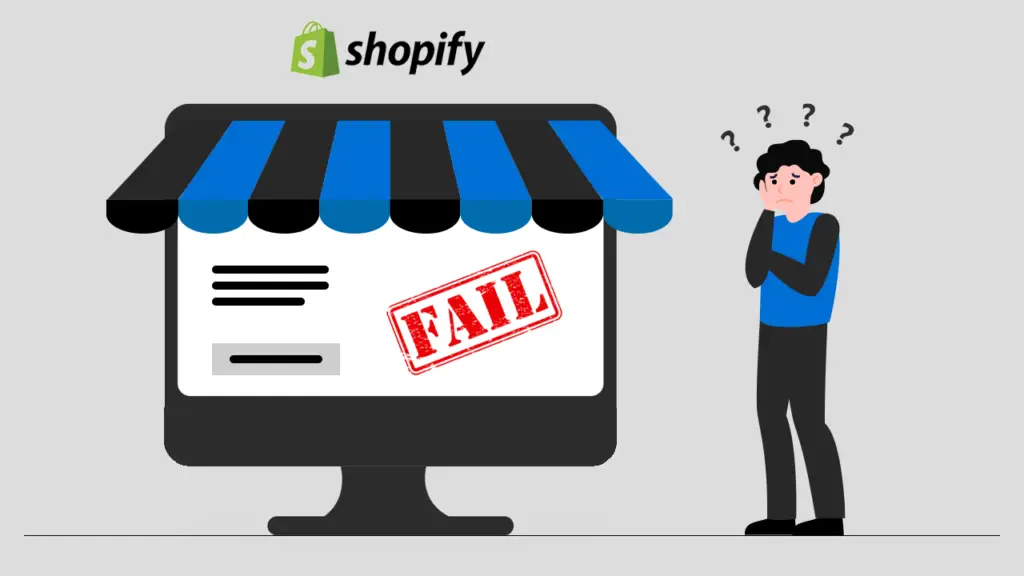There are currently 6,000 Shopify apps available on the Shopify App Store, with 12 different categories offered to select from. And the Shopify platform powers over 841,000 stores in the United States alone. But, only about 5 to 10% of these Shopify stores are successful.
Why is there such a steep bell curve for success?
There are several external factors that contribute to winning e-commerce business and establishing and maintaining a successful Shopify store. With nearly 20% of new businesses failing in their first couple of years, and only about 25% surviving their first decade–understanding what makes Shopify stores win or lose is essential for e-commerce business owners.
Let’s look at a few of the reasons why so many stores fail, and what you can do to ensure your Shopify store makes money.
What Are Some Common Reasons Why Shopify Stores Fail?
Establishing a successful e-commerce business is not easy—the low 5-10% success rate reinforces just how difficult it is to get ahead in today’s competition-heavy digital market. With competition higher than ever before, there’s no sure-fire guarantee that your specific online business will be a revenue driver. But, there are indeed several important things you can do to set yourself and your Shopify store up for greater success.
Reviewing why specific Shopify stores fail can also help you build up a stellar online business. By understanding others’ mistakes, you can learn what’s worked (and what hasn’t), and use those findings in building out your own Shopify strategy and success story.
Shopify is one of the best ways you can find online success. With low start-up costs, an easy-to-use interface platform, and customizable, personalized templates, it’s easy to see why this platform ranks high with users.
The platform also offers secure site hosting, so users don’t have to upgrade their own software or web servers. With all the great tools and applications packaged together in one platform, it’s hard to beat the features Shopify offers small business owners (and the customization and value-add available through their different plans).
Understanding your niche and clients
Any business that fails to understand its customer’s needs is destined to fail. The reason is quite simple: If you don’t know what your customers want, you can’t support them or make sales efficiently. For real-life examples of this in today’s market, you need only look to brands that try to appeal to a younger demographic while their clientele is older and more financially established.
Misinterpreting your audience or consumer persona can steer you away from your business niche and invariably waste your time, money, and marketing efforts. When it comes to your clients, always strive for authenticity. Be original, honest, and strive to deliver an accessible and easy-to-use site experience that beautifully captures your business mission, products, and services. Your customers will see this in your marketing and website, and trust your expertise. Understanding your niche and clients can directly correlate to higher traffic, online sales, and customer loyalty.
*Need help calculating the potential profits of a Shopify store? Our blog post on How Much Does an Average Shopify Store Make? provides the perfect guide to help you calculate your expected earnings.
Aligning your products with customer goals
Chances are you’ve heard the phrase, “the customer is always right”. But, there’s a harsh truth here that isn’t as commonly known. Although the customer may always be right, many customers don’t care about you—they only care about their own goals and needs.
Most consumers visualize the achievement of a goal through the purchase of a product. Buying a product or service is often done to solve a problem or need. That’s why it’s important to align your products with your customers’ goals in mind. Modern advertisement is all about lifestyle, and selling that lifestyle as a pathway to achieve goals and find success. Once you can identify your customers’ goals, you can offer the right products and start making a profit.
Mobile responsive websites
It may come as no surprise that roughly 6.4 billion mobile devices are being used by today’s consumers. Nearly one in three people own a smartphone, and naturally, smartphones are one of the most popular digital devices used by people making online purchases.
Having an established mobile interface in which to interact with your customers is essential. Many stores fail because they don’t have a mobile-friendly website. Building a mobile-optimized website from the start can solve this problem—and ultimately save you costs on app development.
Storefront quality
The most common cause of failure among e-commerce businesses is poor storefront quality. Consumers are more likely to doubt your products and avoid making a purchase if they believe you might be a fraudulent entity.
Examples of poor storefront quality include misspellings, grammatical mistakes, vague or erroneous product descriptions, and no or poor-quality product images. Trust is a very important aspect of e-commerce, and if your store is guilty of using low-resolution images, plagiarized content, or bad design there’s a good chance your less-than-stellar storefront quality is holding you back.
Shopify makes it easy to build a top-quality, beautiful, and effective site. Shopify features a variety of free and low-cost templates you can use to add to your site’s quality, too (with a theme that works well with just about any business niche).
✳️ Looking for ways to make money with Shopify? Our blog post on How Can I Make Money With Shopify provides useful tips and strategies to help you find success as a Shopify store owner. Learn how to identify attractive markets, create valuable products, and manage your operations for maximum growth potential.
Customer service
Another common reason why many Shopify stores fail is bad customer service. No matter how good your product is, one bad customer service interaction can change your reputation with clients overnight.
Amazon has been driving quality customer service practices for over a decade and driving successful sales as a result. This is a good model to follow for any e-commerce business or Shopify store. Basic interactions like offering product returns and refunds, and letting your customer’s comment, rate, or submit complaints is key. Handling both positive and negative interactions quickly and in a straightforward manner ensures your customers have a better shopping experience. And positive client interactions can build loyalty.
The upside of using Shopify is that you don’t need a complicated game plan for managing your e-commerce customer service. The platform has a host of great customer service apps available to choose from. You can also integrate social media, email, and chat features—all to help you better manage customer issues swiftly, and increase your overall site performance.
What Do You Need to Be Successful on Shopify?
In addition to the issues and mistakes we’ve discussed thus far, there are several factors you should consider when building your Shopify success strategy.
Through several recent Shopify e-commerce studies, five key trending metrics are noted with nearly every successful Shopify store. Let’s look at what those factors are, and how you can use them to create and track your own Shopify store success.
- Growing revenue
No surprise here: A growth in revenue is a good indication of your success. Growth however does not come overnight and must be keenly pursued by setting realistic, attainable monthly goals. Being strategic and intentional in your goal setting—and following up regularly, to support their success is foundational to your e-commerce business success.
However, a quick or slight dip in sales doesn’t always mean your business is failing. Keep in mind that your Shopify store revenue will likely go up and down during certain holidays or times of the year, and this isn’t a cause for concern (and likely won’t become a consistent issue).
- Increase in website traffic
Likely the biggest metric of success for any website is an increase in daily visitors and site traffic. Having sizable web traffic allows you to monetize your site–and in many ways, is like packing customers into a brick-and-mortar store. The more foot traffic your store gets, the more chances you’ll make multiple sales. The same goes for your web traffic.
The most successful stores have the most visitors and viewership. And, even if those visits don’t end up converting to a sale, the traffic you’re receiving is still quite valuable for building passive, ad-based income.
Shopify stores generally measure their traffic to track average daily website visitors (some popular stores may even measure visitors per minute). If you see your daily visitor numbers increasing, this is a great indicator of success. (Note: Although this metric reflects that you’re trending towards Shopify store success, it can be an inaccurate metric, if you don’t have good conversions.)
- Better conversions
While a high number of visitors is a bonus for any website, visits to an e-commerce business don’t always correlate to success. A strong e-commerce business model is highly dependent upon positive sales and conversion rates, or the number of website visitors buying a product from your e-commerce business.
Keeping track of metrics like conversion can be useful for building success. Better conversions can illustrate your Shopify store’s progress and sales. For example, The conversion rate is calculated as a percentage. So, if you have 100 visitors and four of them make a purchase, then your conversion rate would be 4%. Anything above 5% is considered a great conversion rate. Maintaining this level of rate can help position your Shopify store among the top 10% of e-commerce sites.
- Product return and refund rate
Good sales mean nothing if you’re seeing five out of every 10 purchases being returned or refunded.
To avoid issues, it’s important to maintain good quality products, so that your store doesn’t suffer from high return or refund rates. These negative shopping experiences can drive potential customers away and even cause you to lose existing customers.
Stores with a bad return rate (more than 3%) also end up losing more money than they make—a leading cause of Shopify store failure. If your store is suffering from a high return rate, this generally can be fixed by taking a closer look at your clients and reevaluating who they are and their needs.
- Average profit per product
You can quantify your Shopify store’s success by its overall revenue per item. For example, if an item costs you $1, and you sell it for $1.50, you have a 50% overall revenue gain. (This measurement is your gross margin and should always be at least 50%)
You’ll want to aim for a 60% or higher profit margin. Anything below this mark implies your expenses are too high, or you’re not evaluating your items properly.
Ensuring Your Own ShopifyStore Success
By understanding what works and what doesn’t work with your clients, employing Shopify’s valuable tools, and leveraging the above five metric trends, you’ll be well on your way to creating greater e-commerce success.
For those looking for expert help with Shopify development, our Shopify development agency can provide the perfect solution. With experienced developers and a wide range of services, your ecommerce site will be in good hands.
If you would like to read more about how much the average Shopify store makes and how you can leverage the Shopify platform to boost your e-commerce business success, be sure to read How Much Does an Average Shopify Store Make?








